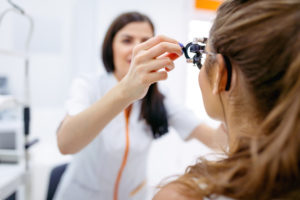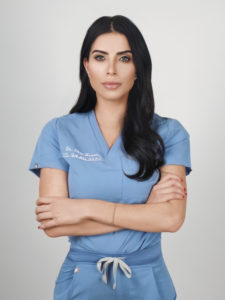January 17, 2022
By Elise Kramer, OD, FAAO, FSLS
Being at the forefront of education and research has always been a priority for me to provide my patients with optimal care.

My experience in the eye care field began in 2012, when I graduated from the School of Optometry at the University of Montreal. I then completed a residency in ocular disease at the Miami VA. My time there included training at the Bascom Palmer Eye Institute. I opened my own practice cold shortly thereafter and wasn’t very busy initially — I’d see only about one patient per week!
To fill the void, I started filling in at other practices and building up my own patient base by networking with local practitioners. My special skills in ocular surface disease and contact lenses helped me grow my practice, and I started getting busy enough to focus on those. I’ve now been in eye care practice for a decade, and as soon as myopia management came to the forefront, I started incorporating it into my practice.
Since I opened my practice, I had been prescribing orthokeratology, but I used it primarily for corrective purposes. I started prescribing it more often with my young myopic patients when it became evident that OrthoK could also slow down axial length growth. Once I had gotten comfortable using OrthoK for myopia management, it was easy to transition into other interventions. Evidence emerged that soft multifocal contact lenses can slow the progression of myopia, and I adopted those in my practice around 2017. When low-dose atropine became available for myopia control, I started using that treatment as well. I’m eager to innovate in my practice by being open to change — not merely for the sake of changing, but to improve my patients’ outcomes. Whenever a new treatment is supported by sound evidence, I try to incorporate it into my practice.
Recognizing the Patient Need
While my practice is now a specialty practice, it started as a primary care practice. With a hand in primary care, I find many patients who end up being specialty patients; I can identify patients who have keratoconus, progressive myopia, or dry eye and thereby convert them to specialty patients.
For example, I read many studies about how detrimental myopia was to a patient’s long-term ocular health. It was evident that I needed to do something. I started to build my myopia management specialty practice by recruiting my own primary care patients. When I examined a child during a comprehensive eye exam whom I thought would be a good fit for a myopia management treatment, I’d have an in-depth conversation with the parent(s). Now, myopia management has become much more referral based. Many eye care practitioners either don’t have the time or the resources to manage myopia, so they now refer their patients to me.
Importance of the Exam
An exam on a myopic child isn’t much different from any comprehensive eye exam. On top of the basic measurements taken during comprehensive exams, I also perform corneal topography, horizontal visible iris diameter (HVID), cycloplegic refraction, and axial length measurement. Last year, I incorporated a biometer to measure and monitor my patients’ axial length. This allows me to measure children before they start treatment, and then every six months to monitor progression and make clinical decisions based on the progression. But the most important part of myopia management is educating both the parents and child on the importance of starting an intervention and the available treatments.
Another critical part of the myopia eye exam in children is determining whether the child has true myopia or keratoconus. A genetic test for keratoconus is available now — the AvaGen test from Avellino — which allows me to get even more information. If the corneal topography comes back a little questionable, or I’m wondering if the myopia is the result of keratoconus or if the child may develop future keratoconus, or if the condition runs in the family, I obtain an AvaGen test.
This is critical information for me, because it affects my treatment plan. If the child has a high genetic risk for developing keratoconus, that immediately eliminates OrthoK as a potential treatment, because the corneal changes caused by the lenses will mask the development of keratoconus. Additionally, the treatments differ for myopia alone versus myopia related to keratoconus. We’re not doing the child a favor by trying one of the novel myopia management treatments if the root cause of the myopia is keratoconus. This can get tricky, because the keratoconus does not usually become evident until shortly after the onset of myopia. For example, the keratoconus may begin around age 12, while the myopia may be manifested by age 8 or 9.
Childhood myopia is usually a refractive condition caused by axial elongation, in which case virtually all available treatments may work to slow progression. However, if myopia results from keratoconus, myopia control treatments won’t slow the progression. It’s important to distinguish between the two conditions to know how to proceed.
Getting Parents and Practitioners on Board
Two of my biggest challenges with myopia management are the costs associated with the treatments and getting parents and referring practitioners on board with preventive care. None of these myopia treatments are covered by insurance, and many patients are willing to sign on only for treatments that are fully covered. Myopia management treatments can be expensive for some, and parents may not understand their worth. Although the treatments should be considered medically necessary, motivating parents to accept them can be difficult.
Much of my work outside of clinical practice is geared toward educating parents and other eye care professionals about myopia management. I do a lot of lecturing at events such as the Global Specialty Lens Symposium and Vision By Design, in addition to speaking to practitioners both locally in South Florida and internationally in places such as Italy, France, and Latin America.
Convincing eye care practitioners to offer myopia management isn’t always easy, but being active in these educational spaces is important to me. Whenever I teach, I learn something — either by asking questions, speaking to co-lecturers, or networking with colleagues who are also passionate about this field. My patients know my reputation; they expect a certain level of service and expertise when they visit my practice. Being at the forefront of education and research has always been a priority for me to provide my patients with optimal care.
Social media has been an incredibly beneficial platform for both practitioners and parents. Social media creates conversations and engagement around critical topics, including myopia management, which helps bring in new patients and engage other practitioners. It has helped to pique the interest of practitioners to start offering myopia management, while also getting parents involved to become knowledgeable enough to demand new treatments.
There’s a reason why childhood myopia is such a common topic for discussion on social media, and when parents see that online, they may be more likely to look into it for their children. Parents who were hesitant to start a myopia management treatment plan with their kids can read things on social media and see that people are talking about it. They are therefore more likely to accept it.
Working Together to Slow the Progression of Myopia
I’d love to see myopia control lenses increasingly available on the U.S. market. New spectacle lens designs currently in development show great promise and could benefit many myopic children — especially those who don’t want to deal with contact lenses and/or eye drops.
All eye care professionals should incorporate myopia management into their practices. At the very least, myopic patients should be referred to qualified colleagues. Every myopic child should have access to modern myopia management. I’d like to see practitioners working together to lower the long-term visual burden of myopia and do everything they can to slow its progression. Myopia management is a necessity, whether the degree is -0.50D or -6.00D. Period.
 |
Dr. Elise Kramer is a residency-trained optometrist in Miami who specializes in ocular surface disease and specialty contact lenses. She was awarded her Doctorate in Optometry from the Université de Montréal in 2012. She completed her internship in ocular disease at the Eye Centers of South Florida and went on to complete her residency at the Miami VA Medical Center. Dr. Kramer serves as the treasurer for the Scleral Lens Education Society (SLS) and is the Delegate of International Relations for the Italian Association of Scleral Lenses (AILeS). She is also a member of the American Optometric Association (AOA) and the International Association of Contact Lens Educators (IACLE). She is a Fellow of the American Academy of Optometry (AAO) and the British Contact Lens Association (BCLA). Dr. Kramer has published several important articles and reviews and participates in clinical research trials. She enjoys lecturing all around the world in several different languages about ocular surface disease and specialty contact lenses. |













